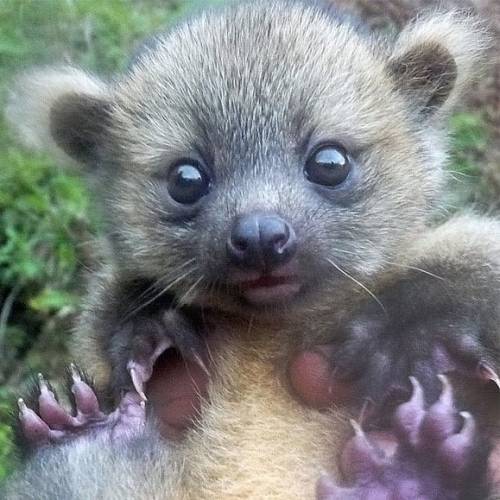#olinguito
Meet the olinguito, Bassaricyon neblina, the newest and smallest documented member of the family Procyonidae, which it shares with raccoons, coatis, kinkajous and olingos.
“Neblina,” the species name, comes from the spanish word for mist, due to the misty cloud forests the animal inhabits.
This one is a baby, and therefore offensively cute. The photo was taken within The Hummingbird Conservancy’s Messina-Paramillo Reserve in Colombia by Juan Rendon.
Olinguitos had been around for a while, but we didn’t realize they were a different species. I particularly enjoy this excerpt from the wikipedia page detailing our ignorance:
“Olinguitos were regularly seen and even publicly exhibited decades before they were recognized as members of a new species. The animal had previously been confused with its taxonomic cousins, the olingos. One such example was Ringerl, an olinguito who lived in the National Zoo in Washington, D.C., for a year and also toured many other zoos. Researchers unsuccessfully tried to breed her with olingos, not realizing she was a different species. Ringerl died in 1976.”
When it was announced that this was,indeed, a new species in 2013, scientists had no clue what the life of this creature in the wild was like: what it ate, how big it’s home range was, whether they were social, how many offspring it had and how often, etc.
But Uriel, the ex-hunter knew. He knew all about them and could spot them better than anyone.
@bioconservancy
#olinguito #bassaricyon #newspecies #procyon #conservation #colombia #biodiversity #neblina
https://www.instagram.com/p/CHfc-fbh0x3/?igshid=f849aszrvdfz
Post link
Meet the olinguito, Bassaricyon neblina, the newest and smallest documented member of the family Procyonidae, which it shares with raccoons, coatis, kinkajous and olingos.
“Neblina,” the species name, comes from the spanish word for mist, due to the misty cloud forests the animal inhabits.
This one is a baby, and therefore offensively cute. The photo was taken within The Hummingbird Conservancy’s Messina-Paramillo Reserve in Colombia by Juan Rendon.
Olinguitos had been around for a while, but we didn’t realize they were a different species. I particularly enjoy this excerpt from the wikipedia page detailing our ignorance:
“Olinguitos were regularly seen and even publicly exhibited decades before they were recognized as members of a new species. The animal had previously been confused with its taxonomic cousins, the olingos. One such example was Ringerl, an olinguito who lived in the National Zoo in Washington, D.C., for a year and also toured many other zoos. Researchers unsuccessfully tried to breed her with olingos, not realizing she was a different species. Ringerl died in 1976.”
When it was announced that this was,indeed, a new species in 2013, scientists had no clue what the life of this creature in the wild was like: what it ate, how big it’s home range was, whether they were social, how many offspring it had and how often, etc.
But Uriel, the ex-hunter knew. He knew all about them and could spot them better than anyone.
@bioconservancy
#olinguito #bassaricyon #newspecies #procyon #conservation #colombia #biodiversity #neblina
https://www.instagram.com/p/CHfcqMFBfia/?igshid=io4gojz7yxdm
Post link
Olinguito
The olinguito is a part of the raccoon family and was discovered in 2013 by the Smithsonian National Museum of Natural History. This interesting creature inhabits parts of South Africa within the Andes Mountains.
The olinguito eats mostly fruits making it omnivorous. However, they sometimes feed on insects and nectar.
These furry little guys share it’s genus with five other species called Bassaricyon. All of the species within this genus live in the Andes however, the olinguito lives the highest in elevation. Being 5,000 to 9,000 ft.
Currently, the olinguito in not threatened. However due to deforestation and urbanization, these creatures are near threatened. No efforts that are known of are being put into reducing habitat destruction.
Photo by: rarecollection.ch via Flickr
Post link



